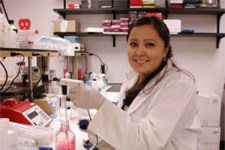Bringing Hope to Her People

Monica Yellowhair
2002 BS in Microbiology; 2005 MS in Chemistry
College of Engineering, Forestry, and Natural Sciences
So often we perceive heroes to be colorful, caped characters—animated animals that are able to speak or bulked-up humans with double identities. But perhaps the real heroes, the people whom we should admire and aspire to be, are more like Northern Arizona University alumnus Monica Yellowhair. A woman with no cape or secrets, Yellowhair is simply a scientist in a lab coat who has dedicated her academic career and nearly 12 years of research to help the people from her northern Arizona community who may have suffered DNA damage from uranium exposure.
Early in her childhood in Kayenta, Arizona, on the Navajo Reservation, Yellowhair discovered the passion that eventually took her to the biology lab. “I grew up in an area that exemplifies the essence of beauty, and because of this, I have been interested in science ever since I was just a little girl.” When she first arrived in Flagstaff in 1998, she thought she might fulfill her passion for science through teaching, and began her bachelors in science secondary education. But it was during her sophomore year, while completing a teaching internship at her hometown high school, that Yellowhair received the opportunity that changed her life. Through the university’s Minority Student Development Program, she was offered a position in an “actual” research laboratory. “Once I was in the lab, I realized I enjoyed it more than I did teaching. It really was where I belonged,” she says. So she changed her major to microbiology, and she hasn’t left the lab since. In fact, two science degrees later, and as a fifth-year PhD candidate in pharmacology and toxicology (with a minor in cancer biology) at the University of Arizona, Yellowhair continues the work she began at Northern Arizona University. “I study how exposure to depleted uranium might cause the DNA damage that can increase vulnerability to cancer, specifically how exposure interferes with DNA repair,” she says. “The available research on uranium is limited, and much of it focuses only on radiological activity, causing lung cancer and leukemia.” Yellowhair aspires to one day prove that even the uranium seeping out of materials left behind in abandoned mines, although less-potent, is radioactive enough to be dangerous. The sooner she can prove the relationship between depleted uranium and cancer, she says, the sooner she will bring healing, prevention, and government compensation to her community.
According to Yellowhair, this task will not be an easy one. Uranium mine workers need to provide the federal government with the required paperwork to receive compensation for medical expenses and hardships related to radiation exposure. However, much of their documented medical background may not be considered sufficient, in part because Native Americans may prefer to seek cultural medical assistance and not go to the American Indian Health Services.
“Until we can prove and document that uranium contamination reaches much further than the boundaries the government determines, that uranium exposure can cause DNA damage, that the threat of cancer can be caused by uranium’s chemical properties and not just its radioactivity, and that this damage can lead to many cancers, then there are families who are not receiving the compensation they deserve,” she says.
Yellowhair is uncertain as to exactly what she will do when she receives her PhD in 2011, but she knows that she will continue to work for her people. She hopes she can collaborate with tribal governments, especially the Tribal Environmental Protection Agency. Such collaboration make perfect sense, for her work in undergraduate research began with collaboration.
“I was fortunate to start my research involving the chemical genotoxicity of depleted uranium with the Partnership for Native American Cancer Prevention at Northern Arizona University (NAU),” she says. “This wonderful partnership gave me the privilege to collaborate with many people at the University of Arizona (UA) and NAU. With my master’s degree in hand, I knew I wanted to continue the research on uranium and obtain a doctorate degree in toxicology.”
Yellowhair has listened to mineworkers’ stories and heard of the family hardships since she was a child. She has seen first-hand the difficulties tribal members experience from direct uranium exposure and from the continued exposure to depleted uranium. “On the Navajo reservation, there are hundreds of abandoned uranium mines,” she says. “Many prospectors shut down the mines once they had what they needed for nuclear weapons and power generation, and the owners left town without properly sealing the mines.” The neglect, the history, and the stories sadden Yellowhair, but ultimately she is inspired. “The hardships and suffering of my people remind me that what I’m trying to do, in some small way, will help.”
